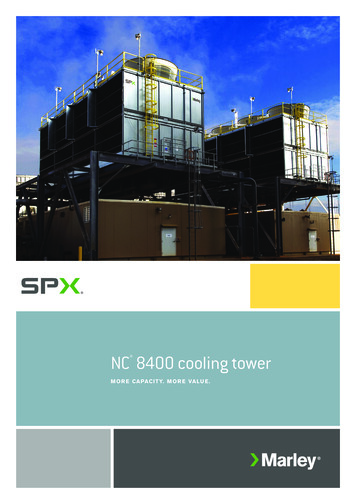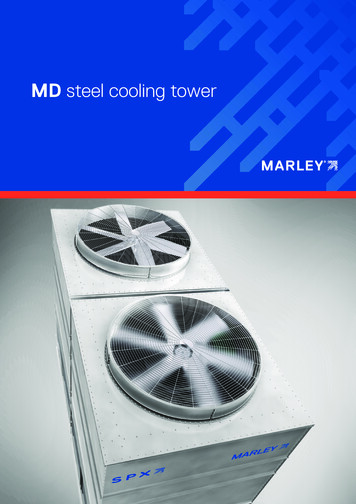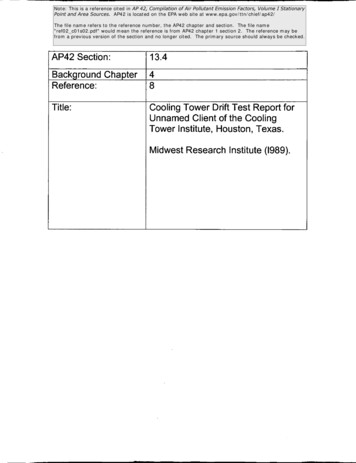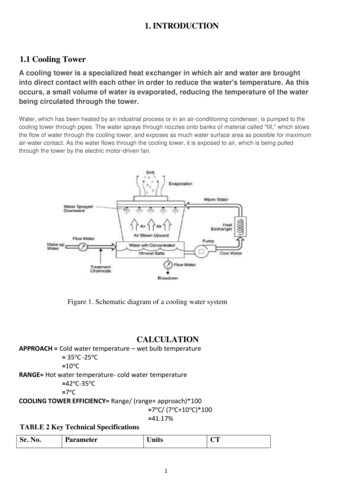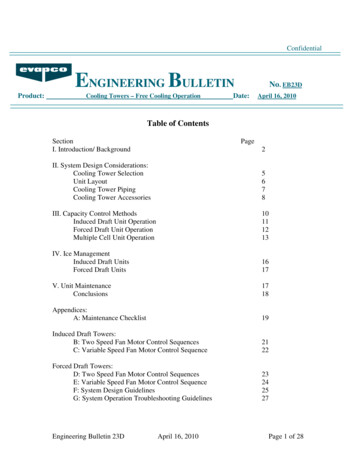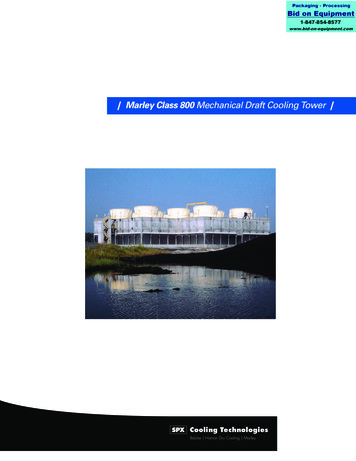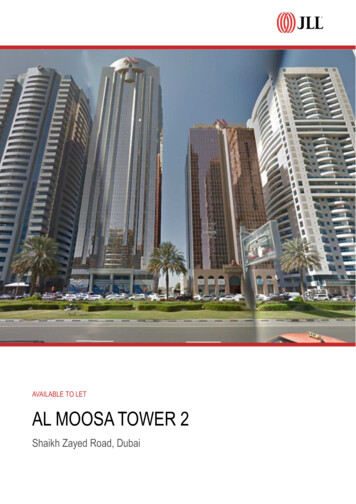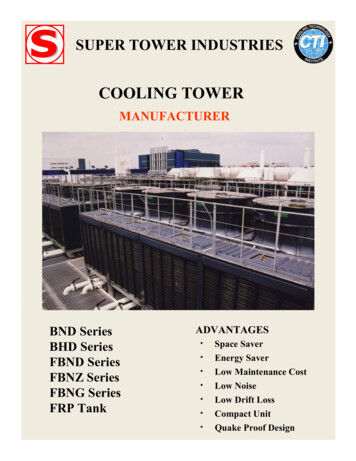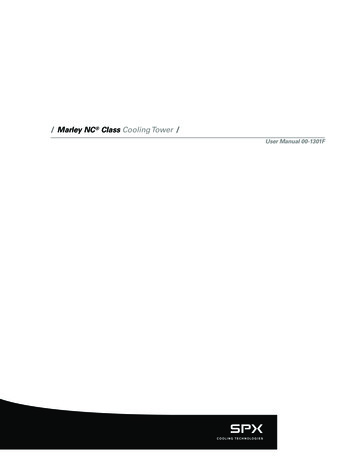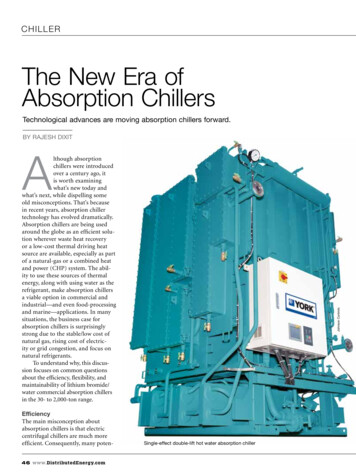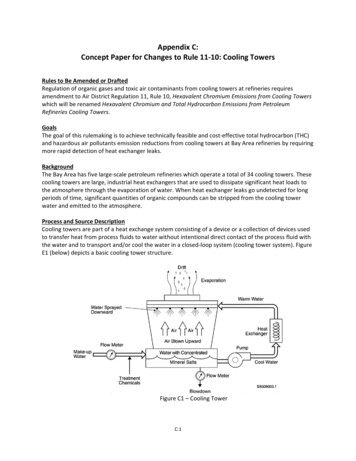
Transcription
Appendix C:Concept Paper for Changes to Rule 11‐10: Cooling TowersRules to Be Amended or DraftedRegulation of organic gases and toxic air contaminants from cooling towers at refineries requiresamendment to Air District Regulation 11, Rule 10, Hexavalent Chromium Emissions from Cooling Towerswhich will be renamed Hexavalent Chromium and Total Hydrocarbon Emissions from PetroleumRefineries Cooling Towers.GoalsThe goal of this rulemaking is to achieve technically feasible and cost‐effective total hydrocarbon (THC)and hazardous air pollutants emission reductions from cooling towers at Bay Area refineries by requiringmore rapid detection of heat exchanger leaks.BackgroundThe Bay Area has five large‐scale petroleum refineries which operate a total of 34 cooling towers. Thesecooling towers are large, industrial heat exchangers that are used to dissipate significant heat loads tothe atmosphere through the evaporation of water. When heat exchanger leaks go undetected for longperiods of time, significant quantities of organic compounds can be stripped from the cooling towerwater and emitted to the atmosphere.Process and Source DescriptionCooling towers are part of a heat exchange system consisting of a device or a collection of devices usedto transfer heat from process fluids to water without intentional direct contact of the process fluid withthe water and to transport and/or cool the water in a closed‐loop system (cooling tower system). FigureE1 (below) depicts a basic cooling tower structure.Figure C1 – Cooling TowerC:1
Cooling towers can be designed as either natural draft or mechanical draft devices. Natural draft coolingtowers are large hyperbolic structures that look similar to those found at nuclear power plants. They usenatural convection of warmed air to create air to cool the water. Mechanical draft cooling towers uselarge fans to force air either through or across the water to cool it.Regardless of the design, a small proportion of the cooling water is entrained in the updraft as mist,commonly called drift. When the water in the droplets evaporates, any dissolved solids in the coolingwater form particulate matter.1When heat exchanger leaks occur (from process fluids leaking into cooling water), the volatilization ofhydrocarbons and/or HAPs in the contaminated cooling water lead to emissions. Such leaks tend tooccur when heat exchanger tube sheets fail or when tubes rupture as a result of corrosion or the use ofinferior materials during the exchanger construction process.Emissions resulting from leaks can become significant if heat exchanger leaks go undetected for longperiods of time. In 2010 a heat exchanger leak at a Bay Area refinery resulted in emissions of at least 52tons of VOC over a recorded period of a few weeks. The total magnitude of emissions from the leakevent was greater; emissions from the event were only estimated once the leak was detected, whichwas likely weeks if not months after the leak began.Regulatory History and ContextDistrict Regulation 11, Rule 10 was developed in 1989 to reduce hexavalent chromium emissions fromcooling towers.In 2009, The U.S. Environmental Protection Agency (EPA) promulgated, and in 2013 amended, 40 CFRpart 63, subpart CC, National Emission Standards for Hazardous Air Pollutants from Petroleum Refineries(MACT2 CC). Section 63.654 in MACT CC requires periodic monitoring (monthly or quarterly) of heatexchangers in organic hazardous air pollutant (HAP) service within the heat exchange system for leaks oforganic gases, unless: the minimum pressure on the cooling water side is at least 35 kilopascals (5.1 psi or 10 inches ofmercury) greater than the maximum pressure on the process side, or if an intervening fluid containing less than 5 percent by weight of organic HAP is employedbetween the process fluids and cooling water (provided the intervening fluid is used solely toisolate the process fluids & cooling water and is not is not sent through the cooling tower ordischarged).MACT CC requires leaks to be repaired as soon as practicable after they are discovered.3 But, not allcooling towers are subject to the monitoring, leak, and repair requirements of MACT CC.41Cooling tower water frequently contains additives such as biocides, anti‐foaming agents and anti‐scaling agents,any of which could be emitted as particulate matter2“MACT” stands for Maximum Achievable Control Technology, which is the level of control that the emissionstandards regulation is intended to achieve.3 but no later than 45 days after detecting the leak, unless the repair is not feasible.4Applicability criteria can be found in Section 63.654.C:2
EmissionsThere are five large‐scale petroleum refineries within the Air District’s jurisdiction that operate a total of34 permitted cooling towers. The number of cooling towers per facility varies. One refinery has only onecooling tower while another has 13 permitted cooling towers. Based on the 2013 Air District emissionsinventory, the cooling towers collectively emitted approximately 1.6 tons per day (TPD) of organic gases,estimated using AP‐42 emission factors.5Regulatory Concepts and Proposed RegulationsCooling Tower Emissions have been addressed by the Texas Commission on Environmental Quality(TCEQ). The TCEQ developed Chapter 115 – Control of Air Pollution from Volatile Organic Compounds,SUBCHAPTER H: HIGHLY‐REACTIVE VOLATILE ORGANIC COMPOUNDS to address Highly Reactive VolatileOrganic Compound (HRVOCs) emissions from industrial cooling towers. As part of its strategy to bettercontrol HRVOC emissions, the TCEQ modified a water sampling technique known as the Texas El PasoMethod, now referred to as the Modified El Paso Method (MEPM), and required Texas petroleumrefineries to use the MEPM to detect strippable hydrocarbons from leaking cooling tower heat exchangesystems.6The Texas El Paso Method, developed in the 1970’s employs a “dynamic” or “flow‐through” system forair stripping a sample of cooling tower water and analyzing the resultant off‐gases for VOCs using acommon flame ionization detector (FID) analyzer. The TCEQ developed the MEPM to concentrate on themeasurement of strippable hydrocarbons, compounds with lower molecular weights and boiling pointsthat are generally lost when sampled for purge/trap analyses. When the MEPM is applied, a continuousstream of water is sampled directly into an air stripping column apparatus. Air flowing countercurrent tothe water strips HRVOCs from the water for analysis.The Air District’s staff is concerned about the MEPM sampling method’s ability provide representativehydrocarbon emissions data on a consistent basis. Staff prefers continuous hydrocarbon analysis as amethod of acquiring cooling tower water emissions data. Such a device is already in use in at least oneBay Area refinery. However, Air District staff will consider MPEM and other methods if the refineries areable to demonstrate that they provide comparable data and consistent results. Staff is seeking commenton this issue.Regulation 8, Rule 2, Section 114 states that “Emissions from cooling towers, railroad tank cars, marinevessels and crude oil production operations are exempt from this Rule, provided best modern practicesare used.” Regulation 1, Section 207 defines best modern practices in general as “The minimization ofemissions from equipment and operations by the employment of modern maintenance and operatingpractices used by superior operators of like equipment and which may be reasonably applied under thecircumstances.”Regulation 11, Rule 10 is now proposing a cooling tower‐specific definition. In the draft rule, Staff hascompiled examples of best practices from several sources. Air District staff recognizes that some of theproposed “best modern practices” could be redundant in cases where a cooling tower has a continuoushydrocarbon analyzer installed.5AP‐42, Compilation of Air Pollutant Emission Factors, Volume I: Stationary Point and Area Sources, Fifth Edition,January, 1995, Table 5.1‐26The MEPM is the basis for the monitoring required by U.S. EPA in § 63.654.C:3
Elements to be added to Regulation 11, Rule 10 are as follows:1. THC leak monitoring, repair and minimization requirements for petroleum refinery coolingtowers will be incorporated into an existing regulation that was adopted in 1989 to limithexavalent chromium emissions from all Bay Area cooling towers that were subject to theprovisions of the rule. The regulation’s description will be modified to include THC emissionsfrom petroleum refinery cooling towers.2. Regulation 8, Organic Compounds, Rule 2: Miscellaneous Operations exempts cooling toweremissions provided Best Modern Practices are used. Regulation 11, Rule 10 will define BestModern Practices and will require refinery staff to take steps to ensure heat exchangerequipment is kept corrosion free and in good working order; to make visual and odorinspections on a regular basis; to perform surrogate testing, such as residual chlorinemeasurements every shift, and to track the amount of biocide added to cooling tower water ona daily basis to maintain water chemistry. As mentioned above, staff welcomes comments onhow to best craft this particular provision to avoid redundancy while ensuring timely detectionand repair of heat exchanger leaks.3. The regulation will also require each cooling tower to use parametric monitors to measurecooling tower water hydrocarbon concentrations on an ongoing basis. Refineries must complywith applicable requirements for parametric monitors specified in Regulation 1, Section 523,unless an alternative sampling method has been approved by the APCO.4. The regulation will include a THC concentration standard of 84 ppb (by weight) in the water ofexisting cooling towers and a 42 ppb concentration for new cooling towers. When either ofthese THC standards is exceeded, a leak action response will be required.5. The refinery shall be required to minimize the leak within 5 calendar days and shall repair theleak within 21 days.6. Regulation 11, Rule 10 would also include detailed recordkeeping requirements.Staff proposes that the new requirements in Regulation 11, Rule 10 go into effect on July 1, 2016Control MechanismsNo additional controls are proposed, only additional monitoring and more frequent repair.Costs and Emissions ReductionsEstimated emission reductions are based on implementing a total hydrocarbon concentration standard(for hydrocarbons in cooling tower water) equivalent to the EPA controlled emission factor of 0.7 lbs ofhydrocarbons emitted for every million gallons of recirculated water. The table below lists the estimatedtotal amortized cost (over ten years), total annual cost (capital plus operating), and emission reductionsfor each petroleum refinery to purchase and install continuous hydrocarbon analyzers for their coolingtowers.Capital costs in the table above do not include a probable discount for the cost to purchase multipleanalyzers nor does do the costs include the savings refineries will incur from saving product that wouldhave otherwise escaped during drift loss from the cooling tower. The figure for saved product is yet tobe calculated. Therefore, the costs stated in the table are likely somewhat conservative.C:4
FacilityChevronShellTesoroPhillips 66ValeroEmissionReduction (tpy)239.4227.636.34.39.3Capital Cost( /yr) 35,000 14,000 60,000 35,000 35,000Total AnnualizedCost ( M) 59,000 26,000 99,000 56,000 38,000Request for CommentsOn May 26, 2015, Air District staff published a Request for Comments to solicit comments on our initialregulatory concepts that comprise Phase 1 of the Refinery Strategy, including for this draft rule.Staff received one comment letters dated June 19, 2015 on this rule and the associated concept paperfrom Guy Bjerke representing the Western States Petroleum Association (WSPA).Staff’s responses to the comments are shown below.Comment: Page E:3 of the concept paper identifies that “The Air District’s staff is concerned about theMEPM sampling method’s ability to provide representative hydrocarbon emissions data on a consistentbasis”, but provides no detail with regard to why they have these concerns. WSPA would like tounderstand these concerns, and potentially have the opportunity to identify the situations in which theMEPM (or EPA Method 624) is sufficiently accurate and could be used on a regular basis.Staff Response: The District is concerned that samples collected through the Modified El Paso Method(MEPM) would not be sufficiently representative of the hydrocarbon content of the cooling water to beuseful for establishing technically sound emission limits. The MEPM contains too many variables withinthe method itself that have the potential to be unreliable when used on a routine basis. The Air Districtis open to possible use of the MEPM to detect heat exchanger leaks if it is demonstrated to be asreliable as other methods (such as continuous monitoring or lab testing of samples).Comment: The statements on page E:3 that “Staff prefers continuous hydrocarbon analysis as a methodof acquiring cooling tower water emissions data. Such a device is already in use in.two Bay Arearefiners: Chevron and Shell.” The monitoring systems at both companies have detection limits that arehigher than the 84 ppbw limit that the District has identified, and both companies have also experiencedtechnical issues with those monitors.Comment: The District identifies that they prefer continuous hydrocarbon monitors that two refinerieshave for their cooling tower water; but both of these refineries identified: Technical issues with continuous monitors utilized at those facilities The District significantly underestimated costs (associated with both installation andoperation, including preventive maintenance and calibration); Monitoring levels are higher than the District’s proposed action level of 84 ppbw (0.084ppmw); and Monitors may not be capable of accurately measuring concentrations at 84 ppbw.C:5
Staff Response: Before this letter, Air District staff was unaware of any technical issues that have beenidentified by the two refineries. We presume therefore that these issues did not impede the refineries’ability to comply with applicable regulations/permit conditions. Nonetheless, we are interested indetails on technical issues and will consider those when drafting the next version of the regulation.Staff is also interested in receiving cost estimates for the installation, operation, preventivemaintenance, and calibration of the continuous THC monitors. Please include the make and model ofthe continuous THC monitors you have evaluated and provide vendor/manufacturer information thatsubstantiates the limitations of the devices to measure THC concentrations below 84 ppbw.Comment: The concept paper seems to imply that what is being proposed has been achieved in practicein the Bay Area, however, the proposal merely combines different monitoring practices and leak levelsincluded in different refinery permits without sufficient research into whether or not the conditions allwork together. In addition to the fact that the existing continuous monitors’ detection limits are nowherenear the 84 ppbw level, we are only aware of the 84 ppbw limit being applied to one refinery, where it isapplied to the difference between the concentrations in the return water and supply water (not just thereturn water), and compliance is based on monthly (not continuous) sampling and laboratory analysis(rather than monitoring). WSPA believes that monitoring once a month is much more feasible and wouldbe consistent with EPA “Maximum Achievable Control Technology” (MACT) standards [40 CFR63.654(c)4].Staff Response: Regulation 11‐10 is intended to be independent of the MACT CC. It is applicable to morecooling towers, and can be more stringent in other ways. The 84 ppbw action level in the draftRegulation 11‐10 was derived from the controlled VOC emission factor in EPA’s method for calculatingemissions from controlled and uncontrolled cooling towers (AP‐43, Table 5.1‐2). The draft Regulation11‐10‐204 will be amended to state that the above action level applies to the inlet upstream of thecooling tower (hot side). The Air District is open to discussing other methods that will reliably andquickly identify leaks in heat exchangers. A monthly sampling routine could allow for a leak to goundetected for weeks.Comment: The 84 ppbw limit is being applied at only one refinery, where it is applied to the differencebetween the concentrations in the return water and supply water (not just the return water), andcompliance is based on monthly (not continuous) sampling and laboratory analysis (rather thanmonitoring). WSPA believes that monitoring once a month is much more feasible and would beconsistent with EPA “Maximum Achievable Control Technology” (MACT) standards [40 CFR 63.654(c)4].Subsection 11‐10‐305.2 of the rule language allows 3 calendar days for leak minimization (which is tooshort) and up to 14 calendar days for repair of a leak (which is also very aggressive). WSPA believes thatthe 45‐day repair time in the EPA MACT standard [40 CFR 63.654(d)] is more reasonable. Thecontingency provisions of Subsection 11‐10‐305.2 do not make sense; it states that if repair is nottechnically feasible within 14 calendar days, the owner/operator needs to substantiate their findings tothe APCO’s satisfaction within 5 calendar days from the day the leak was initially detected. The facilitywill likely try to make every effort to make the repair within 14 calendar days, and likely will not knowwhether it is technically feasible to repair the leak within 14 calendar days until the 14th day. Therequirement in Subsection 11‐10‐305.3 to obtain the detailed drawings, signatures, etc. and conduct aroot cause analysis is in five day is not feasible; nor does it seem necessary. Once a leak is found,personnel efforts need to be directed towards isolating where it is and fixing it, rather than preparing aroot cause analysis of what caused it (which in most cases is likely to not even be knowable).C:6
Staff Response: Air District staff has amended the time periods in Regulation 11‐10‐305 as follows: Replace 3‐calendar days with 5‐calendar days and replace 14‐calendar days with 21‐calendardays.For example, if a leak were detected on July 24, 2015 the above amendments would require that theleak be minimized by July 29, 2015; and, be repaired by August 14, 2015 The Air District has removedthe option for facilities to request an extension to minimize and/or repair leaks. Facilities can apply for avariance if they choose to.Comment: Page E:3 of the concept paper identifies that the Regulation 1, Section 207 definition of “bestmodern practices” is “too generic of a definition for cooling tower operations”, yet the exact samedefinition is proposed for Section 11‐10‐201. The District identifies more specific “best modern practices”in Section 11‐10‐306, but provides no support for this listing in the concept paper.Staff Response: As part of its review of refinery Title V permits in 2004, EPA Region IX had requested theDistrict to provide justification as to why cooling towers were exempt from Regulation 8‐2‐301. TheDistrict determined that at least one (or more) Bay Area refineries were employing the majority of theBest Modern Practices (BMP) listed in Regulation 11‐10‐306. The District addressed EPAs comment byincluding the BMPs found in the above section in the Statement of Basis for Bay Area refinery Title Vpermits. Codifying in Regulation 11‐10 the specific monitoring methods required to achieve BMP forcooling towers provides clarity.Comment: Section 11‐10‐207.2—in some situations, repairing a leak by “changing the pressure so thatwater flows into the process fluid”—will be problematic from a safety perspective.Staff Response: Air District staff is extremely concerned with safety and wishes to ensure thatregulatory development does not pose potential safety conflict. In light of our shared concern, we arevery interested in learning the nature of any potential safety conflicts and would be happy to discussthem with refinery representatives. Regulation 11‐10‐207.2 is a suggested action to mitigate a leak thatrefineries may use, but are not required to use. It is up to each refinery to decide whether to use or notuse the above option.Comment: Separately, it is unclear whether this rule is targeting total hydrocarbon emissions (asidentified in the title of the draft rule above the table of contents, and the majority of the rule language)or non‐methane organic carbon emissions (as identified in the title of the draft rule on page 11‐10‐2).Staff Response: The target pollutant of draft amendments to Rule 11‐10 is total hydrocarbons (THC). TheAir District will amend the THC definition in Rule 11‐10‐213 as shown below:“Any compound of carbon excluding carbon monoxide, carbon dioxide, carbonic acid, metallic carbidesor carbonates and ammonium carbonate.”References to “non‐methane organic carbon” in the draft amendments to Rule 11‐10 will be replacedwith “Total Hydrocarbon”.C:7
REGULATION 11HAZARDOUS POLLUTANTSRULE 10HEXAVALENT CHROMIUM AND TOTAL HYDROCARBON EMISSIONSFROM PETROLEUM REFINERY COOLING TOWERS11-10-100 tionExemption, Discontinued Chromate TreatmentExemption, Fin-Fan Coolers and HVAC SystemsLimited Exemption, Failure To Use Best Modern Practice11-10-200 DEFINITIONS11-10-201 Continuous Hydrocarbon Analyzer11-10-201202 Cooling Tower11-10-202203 Hexavalent Chromium/Chromate11-10-204 Leak Action Level11-10-205 Leak Repair11-10-206 Petroleum Refinery11-10-207 Petroleum Refinery Cooling Tower Heat Exchange System11-10-208 Petroleum Refinery Cooling Tower Heat Exchanger11-10-209 Petroleum Refinery Owner Operator11-10-210 Responsible Manager11-10-211 Total Hydrocarbon11-10-203212 Water Treatment Chemicals11-10-213 Cooling Tower Return Line11-10-300 alent Chromium RemovalCirculating Water Concentration-Wooden Cooling TowersCirculating Water Concentration-Non-Wooden Cooling TowersLeak Action Requirement11-10-400 ADMINISTRATIVE REQUIREMENTS (Not Included)11-10-401 Petroleum Refinery Cooling Tower Reporting Requirements11-10-402 Best Modern Practices11-10-500 MONITORING AND ng-GeneralMonitoring-GeneralMonitoring-Wooden Cooling TowersOperating Records11-10-600 MANUAL OF PROCEDURES11-10-601 Determination of Hexavalent Chromium in Circulating Water11-10-602 Determination of Hydrocarbon in WaterBay Area Air Quality Management DistrictNovember 15, 198911-10-1
REGULATION 11HAZARDOUS POLLUTANTSRULE 10HEXAVALENT CHROMIUM AND TOTAL HYDROCARBON EMISSIONSFROM PETROLEUM REFINERY COOLING TOWERS(Adopted November 15, 1989)11-10-100 GENERAL11-10-101 Description: The purpose of this Rule is to reduce emissions of hexavalentchromium from all cooling towers and reduce total hydrocarbon emissions frompetroleum refinery cooling towers by eliminating chromium based circulating watertreatment programs.11-10-102 Exemption, Discontinued Chromate Treatment: Sections 11-10-502 and 503 donot apply to cooling tower operators who have not used hexavalent chromium forwater treatment since March 1, 1989.11-10-103 Exemption: Fin-Fan Coolers and HVAC Systems are exempt from the requirementsof this rule.11-10-104 Limited Exemption: Petroleum refinery cooling towers that do not use best modernpractices specified in this rule are limited to 300 ppm and 15 lbs/day hydrocarbon.11-10-200 DEFINITIONS11-10-201 Continuous Total Hydrocarbon Analyzer: An Air District-approved parametricmonitoring device that measures the total hydrocarbon concentration in cooling towerwater to detect leaks in the heat exchange system.11-10-201202 Cooling Tower: Any open water recirculation device that uses fans or natural draftto draw or force air to contact and cool water by evaporation. A device used to shedwaste heat to atmosphere using evaporative cooling.11-10-202203 Hexavalent Chromium/Chromate: Hexavalent chromium is a cancer-causingtoxic substance existing as part of various inorganic chromate compounds, forexample, sodium dichromate or lead chromate.11-10-204 Leak Action Level: A total hydrocarbon concentration of greater than 84 ppbw asmeasured by a District-approved continuous total hydrocarbon analyzer upstream ofthe cooling tower sump (hot side) at the cooling water return line on existing coolingtowers that were in operation prior to July 1, 2016. New or modified cooling towersoperated after this date are subject to a total hydrocarbon leak action level of 42ppbw. The leak action level is the absolute total hydrocarbon concentrationmeasured upstream of the cooling tower sump (hot side).11-10-205 Leak Repair: A leak repair shall reduce the concentration of hydrocarbon in coolingtower water to comply with the applicable leak action level and may include but is notlimited to the following actions:205.1 Permanent physical repair of leaking equipment, replacement of equipment,and/or blocking or plugging equipment.205.2 Replacing the heat exchanger or heat exchanger bundle; or permanentlyisolating, bypassing, or otherwise removing the leaking heat exchanger from serviceuntil it is otherwise repaired.11-10-206 Petroleum Refinery: A facility that is located on one or more contiguous or adjacentproperties, and under common control, that processes crude oil to produce productssuch as gasoline, diesel fuel, aviation fuel, lubricating oils, asphalt or petrochemicalfeedstocks.11-10-207 Petroleum Refinery Cooling Tower Heat Exchange System: A heat transfersystem using evaporative cooling.11-10-208 Petroleum Refinery Cooling Tower Heat Exchanger: A heat transfer deviceutilizing cooling water.Bay Area Air Quality Management DistrictNovember 15, 198911-10-2
11-10-209 Petroleum Refinery Owner/Operator: Any person who owns, operates, orexercises operational control over the majority of operations at a petroleum refinery.The refinery owner/operator is responsible for compliance with this rule for theentirety of the petroleum refinery, including any refinery processes or auxiliaryfacilities that may be separately owned or operated. Any person who owns, operates,or exercises operational control over a portion of a petroleum refinery that is less thana majority of the total refinery operations must provide the Owner/Operator withinformation sufficient to allow the owner/operator to comply with this rule, and mustmake that information available to the APCO upon request.11-10-210 Responsible Manager: An employee of the facility or corporation who possessessufficient authority to take the actions required for compliance with this rule.11-10-211 Total Hydrocarbon: Any compound of carbon excluding carbon monoxide, carbondioxide, carbonic acid, metallic carbides or carbonates and ammonium carbonate.11-10-203212 Water Treatment Chemicals: Any combination of chemicals added to coolingtower water including tracers, corrosion inhibitors, antiscalants, dispersants, biocides.11-10-213 Cooling Tower Return Line: Water flowing into the cooling tower sump from heatexchanger(s) upstream of the cooling tower sump (hot side).11-10-300 STANDARDS11-10-301 Hexavalent Chromium Removal: Effective March 1, 1990, a person shall notoperate any cooling tower that uses hexavalent chromium chemicals.11-10-302 Circulating Water Concentration-Wooden Cooling Towers: Effective March 1,1990, a person shall not operate a wooden cooling tower in the District unless thefollowing requirements are met:302.1 March 1, 1990 to September 1, 1990: Hexavalent chromium levels in thecirculating water are not to exceed 8 milligrams/liter of circulating water302.2 After September 1, 1990: Hexavalent chromium levels in the circulatingwater are not to exceed 0.15 milligrams/liter of circulating water.11-10-303 Circulating Water Concentration-Non-Wooden Cooling Towers: Effective March1, 1990, a person shall not operate a non-wooden cooling tower unless thehexavalent chromium levels do not exceed 0.15 milligrams/liter of circulating water.11-10-304 Leak Action Requirement: Effective July 1, 2016, if cooling tower water containshydrocarbon concentrations greater than the applicable leak action level, theowner/operator shall minimize the leak as soon as practicable or within 5-calendardays,and repair the leak and/or remove the defective piece of equipment from servicewithin 21-calendar days of first detecting the leak.11-10-400 ADMINISTRATIVE REQUIREMENTS11-10-401 Petroleum Refinery Cooling Tower Reporting Requirements: When the samplingof cooling tower water triggers a leak action level the owner/operator shall:401.1 Within one calendar day, notify the APCO of the hydrocarbon, pH, iron andchlorine concentration in the cooling water at time and date of leak discovery.List all of the heat exchangers that are served by this cooling tower.401.2 Within five calendar days, notify the APCO how and where the repair wasmade, cause of the leak, hydrocarbon speciation and if further repair orreplacement is required at next turnaround.11-10-402 Best Modern Practices: Effective July 1, 2016, the owner/operator shall minimizetotal hydrocarbon (THC) emissions from cooling tower equipment and operations byemploying best modern practices that shall include but is not limited to:402.1 Use of an Air District approved continuous total hydrocarbon analyzer in thecooling tower return line to measure THC concentration in cooling towerwater prior to exposure to air;402.2 Close examination of all heat exchangers upstream of the cooling towerduring turnaround for corrosion/damage and back flushing;Bay Area Air Quality Management DistrictNovember 15, 198911-10-3
402.3Repassivation of the steel contained in the heat exchangers duringturnaround;402.4 Seal tubes within the heat exchangers if there is evidence of corrosion orpitting
34 permitted cooling towers. The number of cooling towers per facility varies. One refinery has only one cooling tower while another has 13 permitted cooling towers. Based on the 2013 Air District emissions inventory, the cooling towers collectively emitted approximately 1.6 tons per day (TPD) of organic gases,
